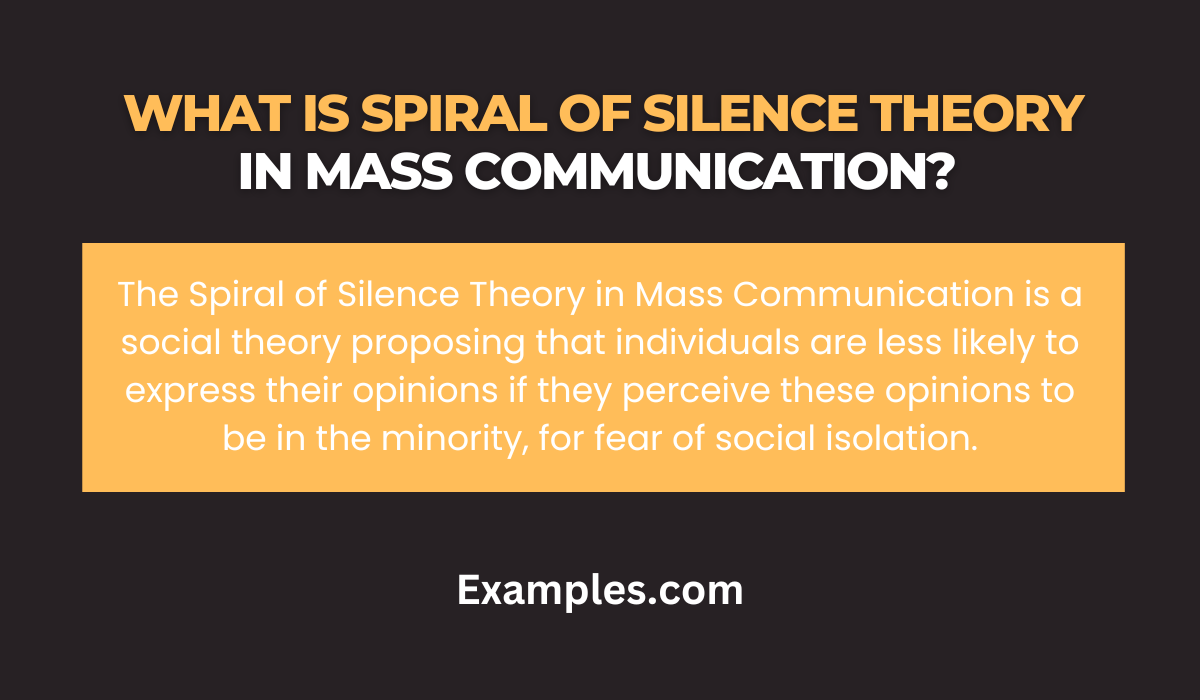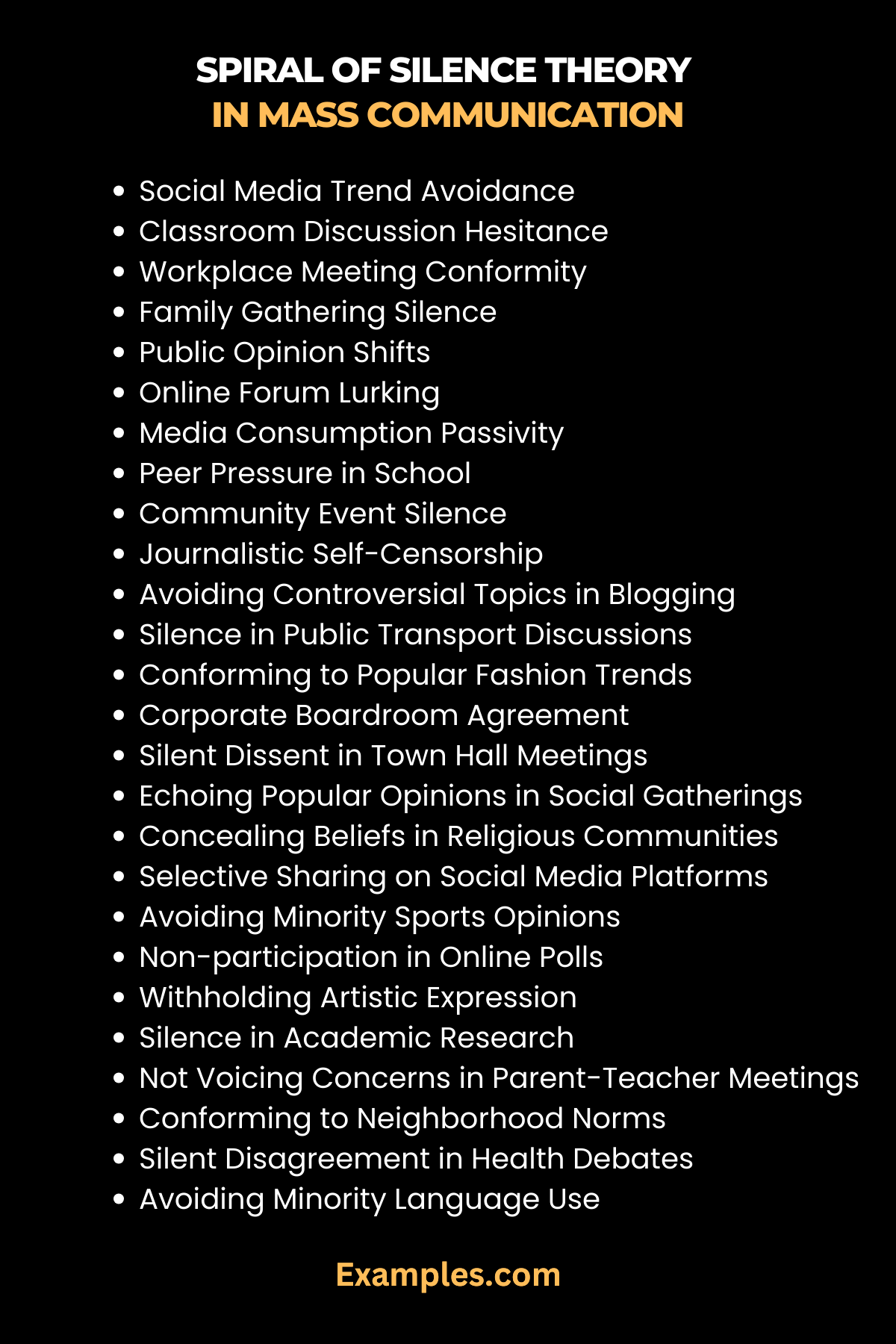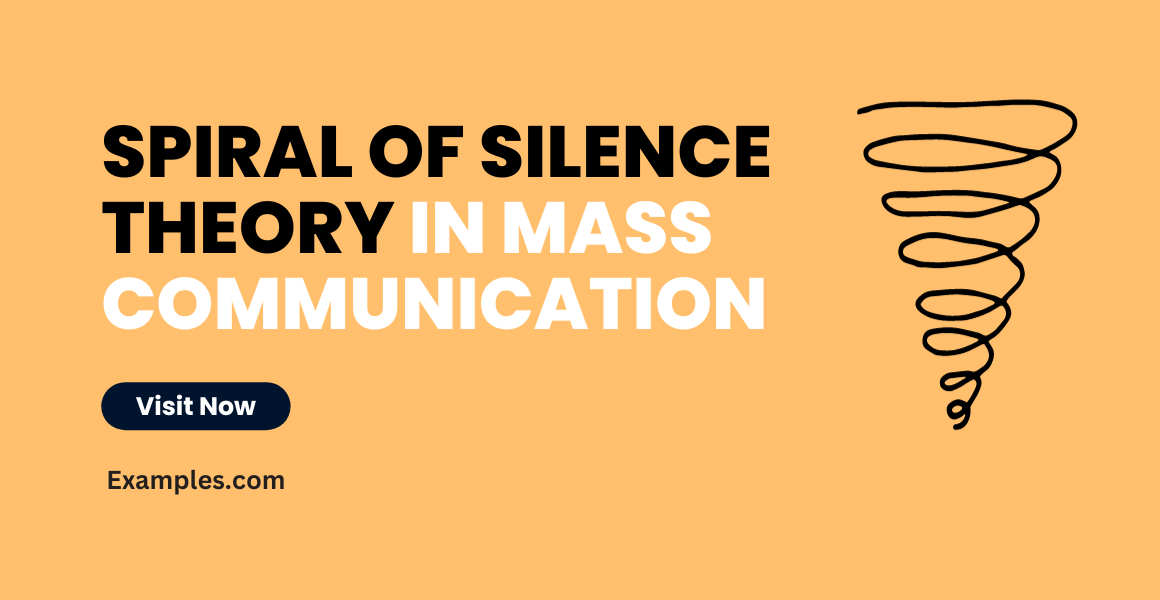29+ Spiral of Silence Theory in Mass Communication Examples
The Spiral of Silence Theory in Mass Communication reveals how public opinion is molded in society. This comprehensive guide delves into the nuances of this theory, illustrating how it operates in various Mass Communication Scenarios/Situations. We’ll explore real-life Mass Communication Examples, demonstrating its impact across different media platforms. Understanding this theory is crucial for professionals navigating the dynamic world of communication, be it in journalism, public relations, or digital media.
What is the Spiral of Silence Theory in Mass Communication?
The Spiral of Silence Theory is a significant concept in the realm of Mass Communication Theories. This theory, introduced by German political scientist Elisabeth Noelle-Neumann, suggests that individuals are less likely to express their opinions if they believe they are in the minority, for fear of isolation or reprisal. This leads to a perceived dominance of the majority view, even when it might not be the actual majority opinion.
In the context of Mass Communication, the Spiral of Silence Theory explains how media can influence public opinion. It posits that the media’s portrayal of what is the dominant opinion can silence opposing viewpoints. This becomes especially pronounced in modern forms of communication like Social media Mass Communication and Television Mass Communication, where the rapid spread of information and the visibility of opinions are high.
The theory also provides insight into why certain ideas gain momentum and become widespread, while others fade away. This can be particularly observed in political communication, public relations, and social campaigns. Understanding this theory is crucial for professionals involved in Mass Communication Jobs/Careers, as it helps in crafting messages that either challenge or support the prevailing public opinion.

History of Spiral of Silence Theory in Mass Communication
The Spiral of Silence Theory, a pivotal concept in mass communication, was first introduced by the German political scientist Elisabeth Noelle-Neumann in the 1970s. This theory delves into the phenomenon where individuals remain silent when they feel their views are in opposition to the majority opinion. It has profound implications in various aspects of mass communication, including journalism mass communication and social media mass communication.
Emergence and Development
Elisabeth Noelle-Neumann, observing the political climate of Germany, proposed the Spiral of Silence Theory in 1974. The theory emerged from her research on the public opinion and the media’s influence on it. She noticed that people tend to keep their opinions to themselves when they perceive these opinions to be in the minority, for fear of isolation or reprisal.
What is the Best Example of Spiral of Silence Theory in Mass Communication
The Spiral of Silence theory, a concept in Mass Communication Theories, primarily deals with how public opinion is formed and how certain views become dominant while others are pushed to the sidelines. This phenomenon can be observed in various mass communication scenarios, but one of the most poignant examples is the Mass Communication in Social Media.
Social Media: A Modern Example of Spiral of Silence
Social media platforms have become a significant part of modern mass communication, influencing public opinion and individual expressions. Here, the Spiral of Silence theory is evident in how users often refrain from expressing opinions that seem to be in the minority or unpopular.
Case Study: Political Discussions on Social Media
A key instance is political discourse on social media platforms. Users tend to observe the dominant opinions in their social networks and, fearing isolation or backlash, may choose to stay silent if their views are contrary. This silence contributes to a perceived majority opinion, further discouraging dissenting views.
In these platforms, the ‘like’, ‘share’, and ‘comment’ functionalities play a crucial role. Opinions that garner more likes or shares become more visible and are perceived as the majority view. Those that do not align with these views tend to get less engagement, reinforcing the belief that they are minority opinions. As a result, individuals holding these views either adjust their opinions to align with the perceived majority or choose to remain silent.

30 Examples of Spiral of Silence Theory in Mass Communication
Spiral of Silence Theory in Mass Communication: Explore how opinions are formed and muted in social settings. This theory demonstrates the impact of perceived majority views on individual expression, crucial in understanding Mass Communication Scenarios/Situations and Mass Communication Theories. Learn how silence or vocal support shapes public discourse and affects mass media narratives.

- Social Media Trend Avoidance: Seeing friends support a political candidate on social media, but choosing to stay silent because your view differs.
- “I noticed everyone discussing Candidate A, but I didn’t feel comfortable sharing my support for Candidate B.”
- Classroom Discussion Hesitance: In a class discussing climate change, students who question the severity remain silent due to the overwhelming majority opinion.
- “Although I had different views about climate change impacts, the class consensus made me hesitant to speak up.”
- Workplace Meeting Conformity: Agreeing with a popular project idea in a meeting, despite having reservations, to avoid standing out.
- “Everyone seemed excited about the new marketing strategy, so I nodded along, even though I had doubts.”
- Family Gathering Silence: Choosing not to express your unique political views at a family gathering to avoid conflict.
- “At our family dinners, I often keep my political opinions to myself to avoid arguments.”
- Public Opinion Shifts: Changing your publicly expressed opinion on a social issue after noticing a shift in the popular stance.
- “As public opinion on the issue shifted, I found myself gradually adjusting my statements to align with the majority.”
- Online Forum Lurking: Reading discussions on an online forum but not participating due to the dominant tone of the conversation.
- “In the forum, I often read but don’t contribute, especially when the majority opinion is different from mine.”
- Media Consumption Passivity: Consuming news that aligns with the majority’s view, even if it contradicts personal beliefs, due to the prevalence of that perspective.
- “I find myself watching news channels that reflect the popular opinion, even though I might personally disagree.”
- Peer Pressure in School: Students in a school conforming to the popular opinion in a group discussion, even if they personally disagree.
- “In our group discussion, I went along with the popular opinion about the school policy, despite having a different view.”
- Community Event Silence: Attending a community event and choosing not to voice dissenting opinions on a local issue.
- “At the community meeting, I decided not to express my disagreement with the proposed plan, feeling outnumbered.”
- Journalistic Self-Censorship: A journalist refraining from reporting on a minority viewpoint to align with the majority’s perspective.
- “As a journalist, I sometimes avoid covering stories that might go against the predominant public sentiment.”
- Avoiding Controversial Topics in Blogging: A blogger decides not to write about contentious issues fearing backlash from the majority of readers.
- “I avoided discussing the controversial policy on my blog, as most of my readers seem to support it.”
- Silence in Public Transport Discussions: Choosing not to participate in a debate on public transport about a sensitive social issue.
- “On the bus, people were debating immigration policies, but I stayed quiet to avoid conflict.”
- Conforming to Popular Fashion Trends: Wearing clothes that are in trend, despite personal dislike, to fit in with the majority.
- “Even though I prefer a different style, I wear these trendy clothes to blend in with my peers.”
- Corporate Boardroom Agreement: Agreeing with the majority in a corporate decision, despite personal reservations, to maintain harmony.
- “In the boardroom, I often find myself agreeing with the majority, despite having different ideas.”
- Silent Dissent in Town Hall Meetings: Not voicing opposition to a popular community decision at a town hall meeting.
- “At the town hall, I didn’t speak against the popular new development plan, even though I had concerns.”
- Echoing Popular Opinions in Social Gatherings: Reiterating popular opinions in social gatherings to avoid standing out.
- “In social gatherings, I often find myself echoing the popular opinions to avoid feeling isolated.”
- Concealing Beliefs in Religious Communities: Hiding one’s differing religious beliefs in a community with strong religious homogeneity.
- “In my religious community, I seldom express my differing beliefs to avoid being ostracized.”
- Selective Sharing on Social Media Platforms: Sharing content on social media that aligns with the majority view, while withholding personal, differing opinions.
- “I tend to share posts that resonate with the majority view on my social media, keeping my differing opinions to myself.”
- Avoiding Minority Sports Opinions: Not expressing support for an unpopular sports team in a group of fans supporting the rival team.
- “In a group of rival team supporters, I avoid mentioning my support for the other team.”
- Non-participation in Online Polls: Choosing not to participate in online polls when one’s opinion differs from the perceived majority.
- “I often skip online polls if my opinion is contrary to what I perceive as the majority view.”
- Withholding Artistic Expression: An artist avoiding controversial themes in their work to appeal to a wider, more mainstream audience.
- “As an artist, I sometimes avoid controversial themes, opting for more widely accepted subjects.”
- Silence in Academic Research: Researchers avoiding topics that might contradict the prevalent theories or opinions in their field.
- “In my academic research, I often steer clear of topics that go against the dominant theories.”
- Not Voicing Concerns in Parent-Teacher Meetings: Parents not expressing concerns about school policies in meetings, fearing isolation.
- “At the parent-teacher meeting, I didn’t voice my concerns about the new policy, as most parents seemed in favor.”
- Conforming to Neighborhood Norms: Residents conforming to neighborhood norms and opinions, even if they personally disagree.
- “In our neighborhood, I often go along with the common opinions to maintain good relations, even if I disagree.”
- Silent Disagreement in Health Debates: Not expressing personal health beliefs in a discussion dominated by a popular health trend.
- “In discussions about health trends, I usually don’t express my differing opinions to avoid debate.”
- Avoiding Minority Language Use: Choosing not to speak a minority language in a setting where another language is predominantly spoken.
- “In a predominantly English-speaking setting, I refrain from speaking my native language to fit in.”
- Non-disclosure of Music Preferences: Hiding one’s unconventional music preferences in a group with different tastes.
- “I usually don’t talk about my music preferences in my group, as they are quite different from the popular ones.”
- Silent Observation in Online Forums: Observing online discussions on controversial topics without participating.
- “In online forums discussing controversial subjects, I tend to be a silent observer.”
- Withholding Opinions in Celebrity Discussions: Not expressing an unpopular opinion about a celebrity in a group of their fans.
- “When my friends discuss their favorite celebrity, I often withhold my less favorable opinion.”
- Non-engagement in Political Debates at Work: Choosing not to engage in political debates at work to avoid conflicts.
- “At work, I stay out of political debates, especially when my views are in the minority.”
Role of Spiral of Silence Theory in Mass Communication
The Spiral of Silence Theory plays a pivotal role in mass communication, influencing how public opinion is formed and maintained. This theory, developed by Elisabeth Noelle-Neumann, posits that individuals are less likely to express their views if they perceive these views to be in the minority, for fear of isolation or reprisal. In the context of mass communication, this phenomenon significantly impacts media narratives and public discourse.
- Media Agenda Setting: The theory underscores the power of media in setting the public agenda. When certain opinions are consistently amplified by the media, they appear to be the majority view, leading to a spiral of silence among dissenting voices.
- Public Opinion Formation: It guides understanding of public opinion dynamics. Media portrayal of what is socially acceptable can alter the perception of majority opinion, influencing individual beliefs and expressions.
- Influence on Journalism: Journalists and broadcasters, consciously or unconsciously, may contribute to this spiral by giving more coverage to ‘popular’ views, potentially marginalizing minority opinions.
- Social Media Dynamics: In the digital age, the spiral of silence theory is increasingly relevant. Social media platforms often act as echo chambers, where unpopular opinions can be suppressed through lack of engagement or outright hostility.
Importance of Spiral of Silence Theory in Mass Communication
Understanding the Spiral of Silence Theory is crucial for comprehending the dynamics of communication and opinion formation in society.
- Enhancing Media Literacy: Knowledge of this theory helps in fostering critical media literacy, enabling consumers to recognize bias and understand how media might influence public perception.
- Communication Strategy: For professionals in public relations mass communication and advertising, understanding this theory assists in crafting communication strategies that resonate with the perceived majority, or in challenging the dominant narrative to bring minority views to light.
- Political Communication: The theory is particularly significant in political communication. It helps in understanding how political climates are shaped by majority opinions and the media’s role in this process.
- Academic Research: It forms a basis for academic research in communication studies, offering insights into the interaction between media, public opinion, and societal norms.
How to Use Spiral of Silence Theory in Mass Communication
Applying the Spiral of Silence Theory in mass communication requires strategic thinking and an understanding of audience dynamics.
- Media Campaigns: Design media campaigns that either align with the perceived majority opinion to gain wider acceptance or tactfully present alternative views to challenge the status quo.
- Social Media Engagement: Utilize social media analytics to gauge public opinion trends and craft messages that resonate with or constructively challenge these trends.
- Counteracting Bias: Use this theory to identify and counteract biases in media reporting and presentation, ensuring a more balanced and inclusive representation of different views.
- Empowering Minority Voices: In journalism and broadcasting, use this theory as a tool to give a platform to minority opinions, thus breaking the spiral of silence and encouraging a more diverse public discourse.
- Educational Purpose: Teach this theory in academic settings, especially in courses related to mass communication characteristics and media studies, to enhance students’ understanding of media influence on public opinion.
The Spiral of Silence Theory in Mass Communication reveals critical insights into how public opinion shapes media narratives and individual expression. This theory, pivotal in both academic and practical realms of Mass Communication, underscores the influence of perceived majority opinion on minority voices, often leading to a silent public discourse. Understanding this dynamic is crucial for professionals navigating the intricate landscape of Mass Communication, whether in journalism, public relations, or digital media platforms. Embracing diverse perspectives and fostering open communication channels can mitigate the spiral of silence, enriching the discourse in our increasingly interconnected world.



